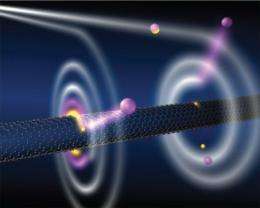April 16, 2010 feature
Black-hole like effect in nanotube and the possibility of new matter states

(PhysOrg.com) -- “For the first time, fields of study relating both to cold atoms and to the nanoscale have intersected,” Lene Vestergaard Hau tells PhysOrg.com. “Even though both have been active areas of research, cold atoms have not been brought together with nanoscale structures at the single nanometer level. This is a totally new system.”
Hau is the Mallinckrodt Professor of Physics and Applied Physics at Harvard University. Along with colleague J.A. Golovchenko, and graduate students Anne Goodsell and Trygve Ristroph, who are in her lab at Harvard, Hau was able to set up an experiment that allows for the observation of capture and field ionization of cold atoms. Their work can be found in Physical Review Letters: “Field Ionization of Cold Atoms near the Wall of a Single Carbon Nanotube.”
“What we observed has a number of interesting fundamental and practical implications,” Hau says. “We even compare the effects to those of a black hole.” She is quick to point out, though, that the atomic scale black hole effect is not gravitational. “It’s an effect created by an electric field, that creates a singular pull on an atom and ultimately rips it apart. Those dynamics have similarities to what happens in a black hole.”
In order to create the effect, Hau and her team grew a single-walled carbon nanotube in their lab. The nanotube was long — 10 microns — and freely suspended. The nanotube was also charged up to 300 volts, a highly unusual situation for a nanotube. Cold atoms were then introduced into the vacuum chamber holding the nanotube. “We launched a cold atom cloud toward the nanotube, and because of its charge, atoms were sucked in and captured,” Hau explains.
Once captured, an atom begins on a spiraling path, orbiting more and more rapidly, until it is ripped apart very close to the nanotube. The electron is sucked in, and a positive ion is shot off at a high energy. This ion is detected when it is ejected by the nanotube.
“When the electron is pulled in, it goes through a tunneling process,” Hau explains. “It has to go through areas that are classically forbidden. The process is quantum mechanical. We can observe the interaction of the atom and the nanotube as the electron is trying to tunnel, and this offers us a chance to peek at some of the interesting dynamics that happen at the nanoscale.”
Another possibility is that this combination of cold atoms with nanoscale structures could lead to new states of matter. “Since we now know how to suck atoms into orbit at such high spin rates, it could lead to a new state of cold-atomic matter that could be super interesting to study,” Hau points out.
Practically, this new system has potential as well. “We could make very sensitive detectors,” Hau says. “Things like ‘atom sniffers’ that detect trace gases could be an application for this work. Additionally, the possibility of single nanometer precision means super high spatial resolution. This system could be used in interferometers — interferometers built on a single chip and based on cold atoms, which would be of importance for navigation, for example.”
For now, though, Hau and her group are focusing on refining their technique. “We want to pursue both the fundamental aspect of creating new cold-matter states, and the development of sensitive detectors. This is something really new, and it has the potential to be developed into practical applications.”
More information: Anne Goodsell, et. al., “Field Ionization of Cold Atoms near the Wall of a Single Carbon Nanotube,” Physical Review Letters (2010). Available online: link.aps.org/doi/10.1103/PhysRevLett.104.133002
Copyright 2010 PhysOrg.com.
All rights reserved. This material may not be published, broadcast, rewritten or redistributed in whole or part without the express written permission of PhysOrg.com.
















